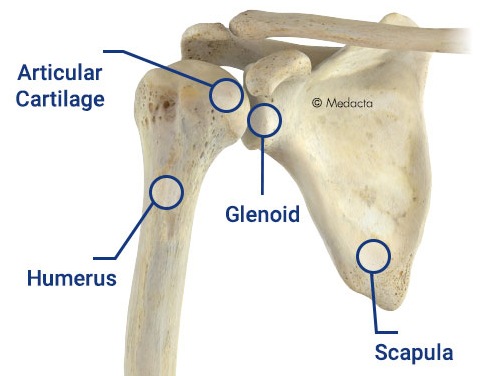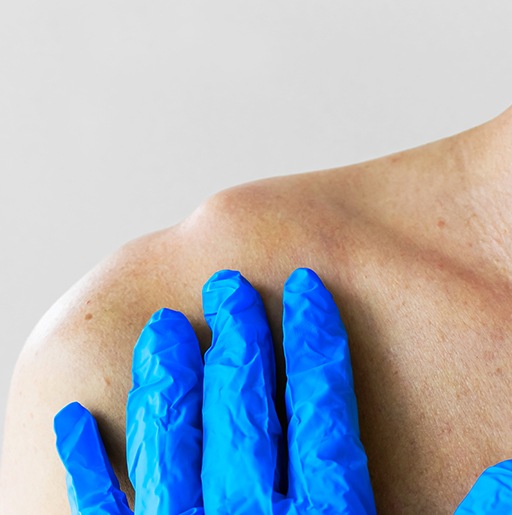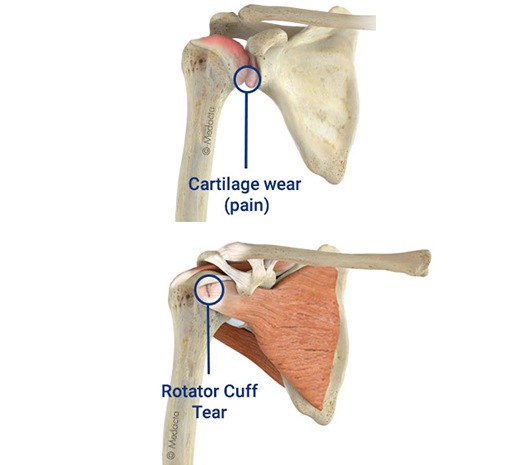CALL US ON (03) 9897 4922 TO MAKE AN APPOINTMENT
Shoulder
The shoulder joint (glenohumeral joint) is a ball-and-socket joint formed by the glenoid (scapula) and the humerus.
It is the major joint connecting the upper limb to the trunk. The top of the humerus (humeral head) is a relatively larger ball that articulates with the glenoid, a relatively smaller socket formed by the scapula. Because the ball is larger than the socket, the shoulder joint is very mobile but not very stable.
A fibrocartilage structure known as the glenoid labrum is attached to the periphery of the glenoid, which increases the overall size of the socket and therefore improves stability of the joint.
Tearing of the glenoid labrum from its attachment to the glenoid can result in instability and pain of the shoulder.
The shoulder joint is surrounded by a capsule. A number of ligaments traverse the bones and further add stability to the joint.

The bony surfaces of the shoulder joint are covered by hyaline cartilage, which allows for smooth, frictionless movement.
Damage and degeneration of the cartilage results in osteoarthritis, which is characterised by pain, stiffness and restriction of movement.
There are four main muscles which surround the shoulder joint, collectively known as the rotator cuff group. These muscles (supraspinatus, infraspinatus, subscapularis and teres minor) are important in guiding movement of the shoulder joint, whilst also providing stability.
Tears or damage to any or all of the rotator cuff muscles reduces stability and is associated with pain and limitation of movement.
The shoulder joint (glenohumeral joint) is a ball-and-socket joint formed by the glenoid (scapula) and the humerus.
It is the major joint connecting the upper limb to the trunk. The top of the humerus (humeral head) is a relatively larger ball that articulates with the glenoid, a relatively smaller socket formed by the scapula. Because the ball is larger than the socket, the shoulder joint is very mobile but not very stable.
A fibrocartilage structure known as the glenoid labrum is attached to the periphery of the glenoid, which increases the overall size of the socket and therefore improves stability of the joint.

Tearing of the glenoid labrum from its attachment to the glenoid can result in instability and pain of the shoulder.
The shoulder joint is surrounded by a capsule. A number of ligaments traverse the bones and further add stability to the joint.
The bony surfaces of the shoulder joint are covered by hyaline cartilage, which allows for smooth, frictionless movement.
Damage and degeneration of the cartilage results in osteoarthritis, which is characterised by pain, stiffness and restriction of movement.
There are four main muscles which surround the shoulder joint, collectively known as the rotator cuff group. These muscles (supraspinatus, infraspinatus, subscapularis and teres minor) are important in guiding movement of the shoulder joint, whilst also providing stability.
Tears or damage to any or all of the rotator cuff muscles reduces stability and is associated with pain and limitation of movement.
SHOULDER INJURIES
Frozen Shoulder
‘Adhesive capsulitis’, commonly known as frozen shoulder, is a condition characterised by progressive stiffness of the shoulder joint. It is associated with pain in the joint, which generally improves with time.
The exact cause of the condition is uncertain, although it is associated with inflammation and fibrosis of the capsule of the shoulder joint. It is generally a self-limiting condition, that usually resolves but can take 18-24 months. A frozen shoulder can occur in anyone, affection around 2%-5% of the population.
Diagnosing frozen shoulder can be made after a detailed history and examination from a clinical professional.
Further imaging is not always necessary to confirm the diagnosis, however investigations such as MRI, X-ray and Ultrasound can be used to exclude other causes for shoulder stiffness and pain.
Treatment of frozen shoulder requires an individualised approach, tailored to the individual needs of the patient.
Rotator Cuff Tears
Rotator cuff tearing is one of the most common problems occurring within the adult shoulder, especially in older and active people. Tearing to the rotator cuff can be symptomatic (painful) or asymptomatic (not painful).
People with symptomatic rotator cuff tears can present with a variety of symptoms. Most commonly, patients will describe pain around the shoulder region, which can be difficult to localise. Patients will frequently have difficulty with overhead activities, reaching behind their back, working at arm’s length and sleeping on the sore side.
Treatment of rotator cuff tears involves both non-surgical and surgical management depending on the exact nature of the tear and the patient presenting with it. Non-surgical treatment will often involve an injection to the shoulder with some physiotherapy. In these circumstances the tear will not heal itself, but patients may be able to function well without repair of the tendon.
In traumatic rotator cuff tears, larger rotator cuff tears or where more conservative management has failed, Mr Booth may recommend repair of the rotator cuff tendon to restore functionality.
Shoulder Instability or Dislocation
People with shoulder instability have loosened shoulder ligaments. Sometimes this looseness is caused by an injury or it can also be caused by repetitive over-use. Tennis, swimming, volleyball, and other sports that require repetitive overhead motion can stretch the shoulder ligaments. Having loosened ligaments can make it hard to maintain stability in the shoulder.
When the shoulder is loose and slips out of place repeatedly, the condition is described as chronic shoulder instability. Chronic shoulder instability means your shoulder can dislocate during active movement or exercise.
A true shoulder dislocation is a very painful injury and most athletes require immediate on-the-field medical care or a trip to the emergency room to have the shoulder put back in place. In some patients however, the episodes are more subtle and feel like the shoulder is popping or slipping out of place or just loose. Some people with shoulder instability may not even have a dislocation but will feel vague pain in the shoulder resulting from looseness in the shoulder joint.
When the shoulder is considered unstable and prone to re-dislocate, surgery may be recommended to prevent further dislocations and the subsequent nerve and tissue damage they can cause.

Shoulder Osteoarthritis
Osteoarthritis of the shoulder is a gradual wearing of the articular cartilage that leads to pain and stiffness. As the joint surface degenerates, the subchondral bone remodels, losing its sphericity and congruity. The joint capsule also becomes thickened, leading to further loss of shoulder rotation. This painful condition is a growing problem in the aging population.
In most cases, diagnosis of degenerative joint disease of the shoulder can be made with careful history, physical examination, and radiography. The symptoms and degree of shoulder arthritis visible on radiography determine the best treatment option.
Mild degenerative joint disease can be treated with physical therapy and over-the-counter anti-inflammatory medications such as acetaminophen or nonsteroidal anti-inflammatory drugs.
More advanced cases of osteoarthritis that are refractory to nonoperative management can be managed with corticosteroid injections. In severe cases, surgery is indicated.
Surgical options include arthroscopic debridement, arthroscopic capsular release, and, in the most severe instances, hemiarthroplasty or total shoulder arthroplasty.

SHOULDER ARTHROSCOPY
Surgery may be a treatment option for many common shoulder problems, particularly those that fail to respond to conservative therapy.
Shoulder arthroscopy is surgery that uses a tiny camera called an arthroscope to examine or repair the tissues inside or around your shoulder joint. The arthroscope is inserted through a small cut (incision) in your skin.
Mr Booth may recommend shoulder arthroscopy if you have a painful condition that does not respond to nonsurgical treatment. A shoulder arthroscopy may relieve painful symptoms of many problems that damage the rotator cuff tendons, labrum, articular cartilage, and other soft tissues surrounding the joint.

Common arthroscopic procedures:
- Removal or repair of the labrum
- Repair of ligaments
- Removal of inflamed tissue or loose cartilage
- Repair for recurrent shoulder dislocation
LESS Common arthroscopic procedures :
- Nerve release
- Fracture repair
- Cyst excision


